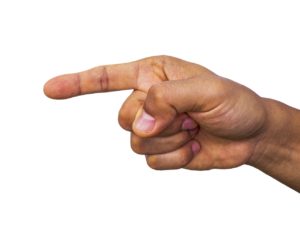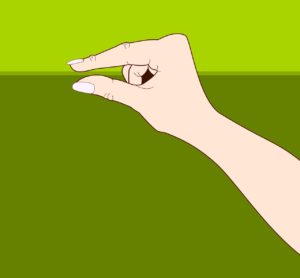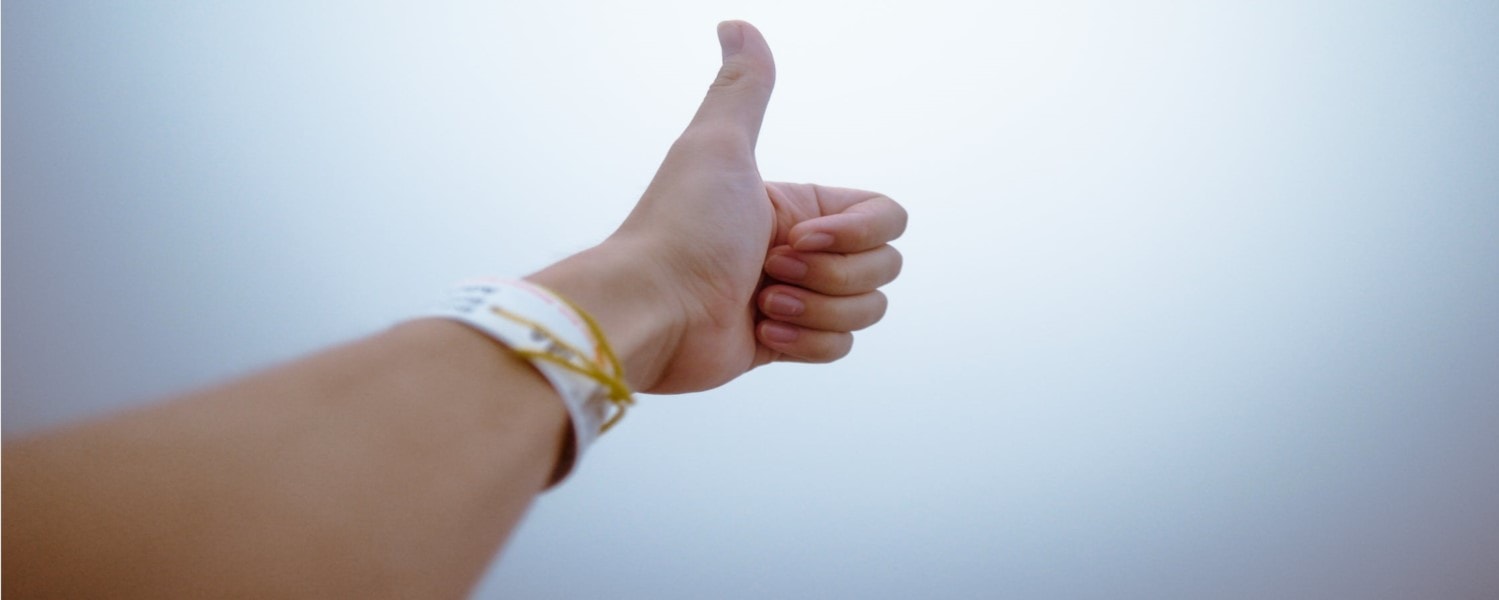This is How to Get the Upper Hand on Hand Gestures
The first time he did it he got me, as it was the last thing I was expecting. From then on I was prepared whenever I saw him.
You are probably wondering what the hell I am talking about!
Just a handshake. But not any ordinary handshake. More like a death grip, squeeze your hand so hard it turns purple type of handshake.
You see, there was a former colleague of mine who when shaking your hand would literally try to exert his dominance with his handshake.
The question is – do these types of handshakes work and what effect did it have on me?

More on that later.
Everything our hands do stems from our brains, either consciously or subconsciously – which makes hand gestures a critical tool in our arsenal for understanding nonverbal behavior.
Did you know that our brains have more nerve connections to our hands than they do to any other part of our body?
Knowing this, I suppose you could say that if the eyes are the windows to the soul, then the hands are the windows to the thoughts, feelings, and emotions of others.
Not only are hand gestures important in how we perceive others, but also important in how others perceive us.
And seeing as how we did a post on eye contact communication a couple weeks ago, we thought it was important to do one on hand gestures.
So, in today’s post, we will take a look at 16 tips on hand gestures that can enhance the power of what you say, as well as better understand what others are trying to convey:
(1) Talk with your hands when giving presentations and speeches
According to research done by Vanessa Van Edwards, the number of views a TED talk got was directly correlated with the number of hand gestures the speaker used. “The bottom TED Talks had an average of 124,000 views and used an average of 272 hand gestures during the 18-minute Talk. The top TED Talks had an average of 7,360,000 views and used an average of 465 hand gestures—that’s almost double! 2
Van Edwards thinks the reason for this is because using our hands helps us to show and build trust. Some of us are naturally good at using our hands, while some need to practice.

You may wonder if using hand gestures improves listeners comprehension of speech. Well, research done by Goldin-Meadow and Alibali showed that “Under ordinary circumstances, listeners comprehend speech with ease. However, if speech is difficult to comprehend, either because it is unclear, ambiguous, or difficult relative to the listeners’ skills, gesture can provide a second channel that makes successful comprehension more likely.” 3
(2) Hidden hands
Such as when someone’s hands are under a table are typically seen to be negative, as if you are hiding something. Think about sitting across from someone whose hands are hidden versus someone whose hands are on the table. It can detract from your honesty and make you seem uncomfortable, withdrawn, or sneaky – like you are trying to hide something. So, keep those hands visible!
(3) Be aware of cultural differences
Hand gestures are different in many countries, so before you go to a country, especially on business, it may be a good idea to do some research on local customs. Some interesting examples:
 In the UK, Australia and Ireland the peace sign turned around with the back of the hand facing the person is akin to flipping someone the bird in North America.
In the UK, Australia and Ireland the peace sign turned around with the back of the hand facing the person is akin to flipping someone the bird in North America.
 Greetings in some countries, (such as America) involve shaking hands. However, in some countries, men will take another man’s hand and hold it, while in some it may be a kiss on the cheek.
Greetings in some countries, (such as America) involve shaking hands. However, in some countries, men will take another man’s hand and hold it, while in some it may be a kiss on the cheek.
 While thumbs up means something positive in America, it means ‘up yours’ in other countries.
While thumbs up means something positive in America, it means ‘up yours’ in other countries.
 Lastly, having your hands in your pockets in some Asian cultures is rude…
Lastly, having your hands in your pockets in some Asian cultures is rude…
(4) Speaking of hands in your pockets…
Unless you are a guy playing pocket pool – no judging, having your hands in your pockets is seen as lacking confidence. UNLESS your thumbs are out, then it shows high confidence and status! While having just your thumbs in your pockets with your fingers out is seen as a low-confidence and low-status.

(5) Rubbing the face
Or stroking the chin or having a finger or hand on the chin can mean someone is thinking about something or evaluating or deciding on something.
(6) Steepling
Or touching the tips of the fingertips of both hands in almost a praying gesture which resembles a church steeple is a sign of confidence and self-assurance. It makes the person appear confident and seem to have the answers. It could also mean that the person is thinking and is commonly seen in superior-subordinate relationships. Think Monty Burns from the Simpsons – excelllllllent!
(7) Interlaced fingers (clenched hands)
Interlaced fingers are seen as a sign of non-confidence and could potentially indicate stress, being scared, nervous, or expecting something negative to happen. The higher the hands are held, the more negative the mood. However, if the hands are interlaced and placed under the chin it could merely mean they are thinking.

(8) Rubbing hands together quickly
Have you ever been with someone who is so excited that they rub their hands together? Rubbing your hands together quickly shows you are expecting something positive to happen. Either that or you are freezing your ass off and try to get warm! Whereas rubbing them together slowly may be an indicator that someone is going to benefit at someone else’s expense.
(9) Rubbing palm with fingers
Taking a finger from one hand and rubbing the palm of the opposite hand may be an indicator of being in a stressful situation. While dramatic rubbing of interlaced fingers is seen as an indicator of distress.
(10) Offensive hand gestures
Your Mom was right when she said, ‘don’t point, it’s rude!’ Most of us are familiar with offensive hand gestures. It is always a good idea to avoid them for obvious reasons. Other than pointing, other offensive hand gestures include snapping at someone, the shocker (if you don’t know what it is, good), and flipping the bird (with my caveat being ‘do as I say, not as I do’). Back to cultural differences, in some countries, they use the middle finger as the ‘come here’ signal.

(11) Quivering or shaky hands
Can be due to various reasons and you need to evaluate them with respect to other body language cues as well as the situation in general. Many times, they can indicate nerves, but there are also times when they could indicate excitement (perhaps when reading Prime Your Pump). Other times, they could be due to having too much coffee or other stimulants or perhaps having a neurological disorder such as Parkinson’s. Again, you need to evaluate them with respect to a person’s baseline or usual behavior.
(12) Frozen hands
Having hands that have all of a sudden stopped moving after being illustrative and emphasizing should catch your eye. According to Joe Navarro, author of What Every Body is Saying, “Research tells us liars tend to gesture less, touch less, and move their arms and legs less than honest people.” This doesn’t necessarily mean the person is trying to deceive you, although it is possible. But it does mean that the brain is having a different thought or sentiment. At the least, you should assess it within the context of what is happening.
(13) Neck touching
When someone is touching their neck while talking it can be a sign of having low-confidence or possibly trying to relieve stress.
(14) Hands behind the back
Many times, you will see someone either standing or walking with their hands behind their back. This is seen as having confidence and power and being almost regal. You may think of your school principal or policeman exhibiting this behavior.
(15) Transitions
Many of the hand gestures we have discussed are dependent on the context in which they happen. For example, someone could be confidently steepling, then receive some news that decreases their confidence and adds a little stress, causing their hands to interlace. Therefore, it is important to watch the transitions between positive and negative hand gestures within the context of what is happening to understand what the person is feeling and thinking.
(16) Handshake
Lastly, handshakes, which are used as a greeting in many countries. Make sure to keep them firm and look the person in the eye. As for the…
Death Grip Handshake…
…I experienced and whether it is recommended. According to Navarro, “I don’t recommend hand jousting to create dominance, as our intentions should be to leave positive impressions when we meet others, not negative ones.” 1
Did it work on me?
No, it made me feel uncomfortable and didn’t make me think he was dominant at all. What it did do however was make me wonder if he was compensating for something…

Your hands can provide a lot of useful information when trying to read others. The trick is to observe and assess that information correctly and in the right context.
Until next time, get a grip and as always…PYMFP!!
–Rick
Use It or Lose It:
Use the following 16 hands gestures to enhance the power of what you say, as well as better understand what others are trying to convey:
 Talk with your hands when giving presentations and speeches
Talk with your hands when giving presentations and speeches
 Be wary of hidden hands
Be wary of hidden hands
 Be aware of cultural differences
Be aware of cultural differences
 Remember no hands in pockets, unless thumbs are out
Remember no hands in pockets, unless thumbs are out
 Rubbing the face or fingers/hand on chin could mean the person is thinking
Rubbing the face or fingers/hand on chin could mean the person is thinking
 Steepling = confidence
Steepling = confidence
 Interlaced fingers = non-confidence
Interlaced fingers = non-confidence
 No offensive hand gestures!
No offensive hand gestures!
 Quivering or shaky hands could mean a variety of things depending on the situation
Quivering or shaky hands could mean a variety of things depending on the situation
 Frozen hands may indicate lying
Frozen hands may indicate lying
 Neck touching could mean nervousness or stress relief
Neck touching could mean nervousness or stress relief
 Hands behind the back can show confidence and power
Hands behind the back can show confidence and power
 Watch for transitions between different hand gestures within the context of what is happening
Watch for transitions between different hand gestures within the context of what is happening
 Be mindful of your handshake
Be mindful of your handshake
When to Use It:
 When trying to enhance the power of what you say, as well as better understand what others are trying to convey.
When trying to enhance the power of what you say, as well as better understand what others are trying to convey.
What Do You Think?
 How mindful are you of your hand gestures as well as others when communicating? Will you be more mindful now after reading this post? Please share your thoughts in the comments below!
How mindful are you of your hand gestures as well as others when communicating? Will you be more mindful now after reading this post? Please share your thoughts in the comments below!

If you enjoyed this post, it would mean the world to us if you shared it with people you care about via any of the social media platforms below!
Popular Previous Posts:
This is Why You Need to Be Careful Using Others Experiences
How to Remove These 7 Wastes From Your Life
3 of the Best Podcast Episodes I Have Ever Heard!
You’re Fired! 10 Things This Mofo Learned By Getting Fired
This is How to Make a Great First Impression Every Time!
References
1 Navarro, J., & Karlins, M. (2008). What every BODY is saying: An ex-FBI agent’s guide to speed reading people. New York, NY: Collins.
2 https://www.scienceofpeople.com/secrets-of-a-successful-ted-talk/
3 https://www.ncbi.nlm.nih.gov/pmc/articles/PMC3642279/
http://www.apa.org/monitor/nov05/gestures.aspx


Hi Rick – this one’s really enjoyable reading. A good speaker always uses hand gestures, more so if employing a visual aid, although this has been largely replaced by the laser pointer. I’ve heard of and use the concept “you talk with your mouth but emphasize with your hands.” It works. So many times (think boring college lectures) the speaker or professor stands completely rigid behind a podium, arms glued to his side, speaking in a monotone about some esoteric bullcrap that no one gives a healthy hoot about. Within 5 minutes the audience drifts into snooze mode, by 10 minutes they are comatose.
I had not previously known about the shocker, and had to google it, Maybe it’s worth a try, however the response may be a bit unnerving.
Jewish people believe there is a distinct use for each one of the five fingers. Howie probably knows these, if not I can tell you. You do illustrate two, first in the What Do You Think portion. That’s the finger of transportation, which I have used often in my starving student days. The second occurs in item (10), that’s the finger of meddling in other people’s business.
There are also various ways of flipping the finger other than the standard middle digit. In addition to the hand gesture, each one has a short phrase that must be said simultaneously.
Hi Dave, thanks as always. Agreed on the hand gestures when speaking. LOL on the shocker! Interesting on the Jewish uses for each finger, I did not know that, thanks for educating me! Be good, Rick